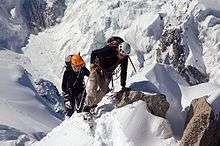Mountain sport
A mountain sport or Alpine sport is one of several types of sport that take place in hilly or mountainous terrain.

All these sports require special equipment, carry a higher level of risk and require specialised training before they can be undertaken safely.
Because mountain sportsmen deliberately go into terrain that is not easily accessible where there are higher risks – dangers such as avalanches, bad weather, mudflows, rockfalls and icefalls - special measures must be taken to mitigate these risks. This is generally known as risk management. Mountain sports include the following:[1]
- Mountaineering
- Climbing
- Klettersteig or via ferrata climbing
- Ski touring, ski mountaineering and its freeriding
- Snowshoeing
- Hiking, especially Hillwalking
- Mountain biking (partly)
- Trekking
- Canyoning
The usual skiing on pistes is not generally counted as a mountain sport, because the use of prepared slopes and the corresponding legal standards reduce risks to a minimum, so that the skier or snowboarder does not have to take account of any significant risks.
Mountain sport tourism
Many mountain schools offer the various mountain sports as guided tours. These enable beginners to try out the various activities under supervision. The leaders of these tours know the likely risks on their tour routes and accompany the party. Some of these tours are targeted at specific groups, such as guided Alpine crossings for beginners, intermediates, older people or singles.[2]
These tours have adapted to the changes in travel behaviour of tourists observed in recent years. For example, studies by the University of Berne have found that travellers expect increasingly individualized and flexible travel deals. They are mainly looking for deals that provide varied and intense experiences.[3]
Mountain sports and conservation
Because mountain sports usually take place in area of relatively unspoilt nature, it is important that participants ensure their activities are carried out in a sustainable and environmentally-friendly way. For this reason guidelines have been prepared by the various mountaineering and alpine clubs. These say, for example, that plants may be photographed but not picked.[4]
In addition to these measures the Alpine countries and the EU have agreed a framework programme for pan-Alpine policy. The agreement is also known as the Alpine Convention and, in addition to conservation, also covers planning, sustainable development, mountain farming, countryside conservation, mountain forests, tourism, soil protection, energy and transport.[5]
References
- Bergsport für alle ...Seien Sie aktiv. Zusammenfassung der Bergsportarten, online auf alpenverein.de, retrieved 1 September 2013.
- Patrick Merhi: Erfahrungsbericht einer Alpenüberquerung. Report dated 26 August 2013. Online at guiders.de, retrieved 1 September 2013.
- Hansruedi Müller: Der Alpentourismus vor großen Herausforderungen Archived 2015-04-02 at the Wayback Machine (PDF, 26 kB). Online at fif.unibe.ch, retrieved 1 September 2013.
- Naturverträglich unterwegs. Maßnahmen zum Naturschutz im Bergsport. Online at alpenverein.de, retrieved 1 September 2013.
- Alpenkonvention Archived 2013-09-01 at Archive.today. Online at the website of the Federal Environment Office (Umweltbundesamt) dated 6 August 2013, retrieved 1 September 2013.
Literature
- Martin Krauß: Der Träger war immer schon vorher da. Die Geschichte des Wanderns und Bergsteigens in den Alpen. Nagel & Kimche, Zürich, 2013, ISBN 978-3-312-00558-1,